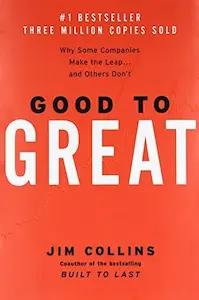Good to Great - Summary
Jim Collins

Introduction
In his book “Good to Great,” Jim Collins explores the concept of what makes a company truly exceptional and how it can sustain long-term success. Through extensive research and analysis of various companies, Collins identifies key factors that differentiate good companies from great ones. This book summary will provide an overview of the main ideas and insights presented in “Good to Great,” highlighting examples and anecdotes from the book to support the key concepts.
The Hedgehog Concept: Simplifying the Path to Greatness
One of the central ideas in “Good to Great” is the concept of the Hedgehog. Collins introduces this concept by comparing two different animals—the fox and the hedgehog. The fox is known for being cunning and adaptable, while the hedgehog has a singular defense mechanism: rolling into a spiky ball. Collins argues that great companies are like hedgehogs—they focus on one thing and do it exceptionally well.
Collins introduces the Hedgehog Concept as a framework for identifying a company’s core focus. It consists of three intersecting circles:
- What you are deeply passionate about
- What you can be the best in the world at
- What drives your economic engine
By finding the intersection of these three circles, a company can identify its Hedgehog Concept and concentrate its efforts on activities that align with it. Collins provides the example of Walgreens, a company that discovered its Hedgehog Concept by focusing on convenience and accessibility in the pharmacy industry.
Level 5 Leadership: The Paradoxical Blend of Humility and Will
Another crucial aspect of greatness, according to Collins, is the presence of Level 5 leadership. Level 5 leaders possess a unique combination of humility and unwavering determination. They are not driven by personal ambition but rather by a deep desire to see the company succeed.
Collins presents the example of Darwin E. Smith, the CEO of Kimberly-Clark, who transformed the company from a struggling paper mill into a leading consumer products company. Smith’s humility and strong will allowed him to make difficult decisions, such as selling off major business divisions, to focus on areas where Kimberly-Clark could excel.
First Who, Then What: Getting the Right People on the Bus
Collins emphasizes the importance of having the right people on board before determining the direction of the company. He argues that great companies prioritize getting the right people in key positions and then deciding on the strategy and direction.
Collins shares the example of David Maxwell, the CEO of Fannie Mae, who focused on assembling a team of talented individuals before making any significant strategic decisions. Maxwell believed that with the right people, the company could tackle any challenge and achieve greatness.
Confront the Brutal Facts: The Stockdale Paradox
“Good to Great” introduces the Stockdale Paradox, named after Admiral James Stockdale, a prisoner of war during the Vietnam War. The paradox states that great companies confront the brutal facts of their reality while maintaining an unwavering belief in their ultimate success.
Collins illustrates this concept through the story of Stockdale himself, who survived years of captivity by facing the harsh realities of his situation while never losing faith in his eventual liberation. Similarly, great companies acknowledge their challenges and setbacks but remain committed to their long-term vision.
The Flywheel Effect: Building Momentum for Sustained Success
The Flywheel Effect is a metaphor Collins uses to describe how great companies build momentum over time. Initially, it takes substantial effort to set the flywheel in motion, but with consistent and persistent actions, it gains momentum and becomes a driving force for success.
Collins provides the example of Walgreens once again, highlighting how the company’s consistent focus on its Hedgehog Concept and continuous improvement led to sustained success. The Flywheel Effect demonstrates the importance of consistent effort and a long-term perspective in achieving greatness.
Technology Accelerators: Using Technology as an Accelerator, Not a Driver
While technology can be a powerful tool, Collins argues that it is not a determining factor in the success of a company. Instead, great companies view technology as an accelerator, using it to enhance and amplify their existing strategies and capabilities.
Collins presents the example of Pitney Bowes, a company that successfully utilized technology to improve its customer service and operational efficiency. By aligning technology with their core values and strategies, Pitney Bowes was able to accelerate its growth and maintain its competitive edge.
Conclusion
In “Good to Great,” Jim Collins provides valuable insights into what separates good companies from great ones. Through the Hedgehog Concept, Level 5 leadership, and other key principles, Collins demonstrates that greatness is attainable for any organization willing to make the necessary commitments and decisions.
By focusing on what truly matters, assembling the right team, confronting the brutal facts, building momentum, and leveraging technology effectively, companies can transcend mediocrity and achieve long-term success. “Good to Great” serves as a guide for leaders and organizations aspiring to make the leap from good to great.